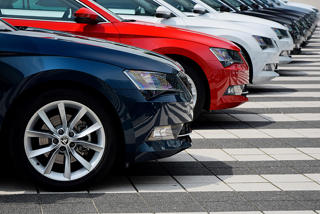Grey fleet can be a cost and duty of care nightmare for organisations, but how does your operation measure up?
Take part in this simple quiz to find out how good yours is – or whether you need to take action to improve it.
Q1 Do you know how many grey fleet drivers you have?
Yes: go straight to question 2
 No: It’s imperative that you know who drives their own car on company business, even if they do so only occasionally.
No: It’s imperative that you know who drives their own car on company business, even if they do so only occasionally.
It’s equally important to remember the term ‘grey fleet’ is now used to describe any vehicles that do not belong to a company, but which are used for business travel. Consequently, grey fleet also includes those vehicles bought via an employee ownership scheme, a privately-rented vehicle as well as privately-owned vehicles.
When they are driven on company business – often in return for a cash allowance or fuel expense – these vehicles fall under the responsibility of an employer. “Ownership of the asset is irrelevant,” says Caroline Sandall (pictured), chair of fleet operators association ACFO. “Businesses, as responsible operators, have a duty of care to extend management of a fleet to those who may only drive occasionally .
“The grey fleet requires managing and the fleet team is best placed to undertake the task.”
RoSPA fleet consultant John Greenhough agrees. “While the vehicle – and any mileage claim – may have a different classification for tax purpose, the use is not classed any differently for health and safety purposes,” he adds. “It must be subject to the same policies of safety that apply to the company’s own vehicles that includes: insurance, tax, MOT, service and licence status.”
Q2: Do you know what they are driving?
Yes: go straight to question 3
No: According to the BVRLA, private cars used for work purposes tend to be an average 8.2 years old with CO2 emissions of 152g/km.
In contrast, the average CO2 of Lex Autolease’s company car risk fleet in July 2019 was 107g/km.
As well as more efficient, company cars also tend to be safer: their age means they are more likely to be fitted with advanced driver assistance systems than grey fleet vehicles, reducing risk.
“Understanding the make-up of the grey fleet is essential for accurate reporting on all measures – not just environmental impact – and can be achieved through a comprehensive grey fleet audit,” says Paul Coley, of Lex Autolease. “This audit then forms the foundation of a managed grey fleet policy, to ensure these vehicles are not only fit for purpose but remain that way.”
John Greenhough, of RoSPA, adds that a simple spreadsheet can suffice when it comes to performing this audit.
He adds: “Older vehicles may run on older Euro standards – Euro 6 is the current standard. They might also have higher emission levels and lower safety standards. But it’s worth bearing in mind that at the time of first registration they met the standards of the day and as long they meet the current MOT standards they remain compliant.”
Q3 Do you place restrictions on what they are driving?
Yes: go straight to question 4
 No: There are many reasons an employer may wish to restrict the type of grey fleet vehicle a driver uses, including safety, efficiency and brand image.
No: There are many reasons an employer may wish to restrict the type of grey fleet vehicle a driver uses, including safety, efficiency and brand image.
The road safety charity Brake recommends fleets stipulate minimum Euro NCAP safety ratings, vehicle age, emission levels, required safety features and essential breakdown cover.
“Many companies have minimum standards when it comes to choosing company vehicles – like age, engine size and fuel type,” says John Greenhough (pictured), of RoSPA.
“This is easy for a company to manage as they are responsible for the purchasing and disposal process.
“For a grey fleet vehicle, this may not be so easy as the driver may not be able to afford a new vehicle or less able to exchange on a regular basis.
“Nonetheless, companies can take the decision to enforce certain criteria on the use of a vehicle – provided they have suitable alternatives for an employee to use for work purposes if required.
“Among the primary objections to using a vehicle would be the type – for example, no soft top convertibles due to ease of entry or higher risk of injury in a roll-over collision.
“And then, of course, there’s the whole question surrounding emissions – this is more the case now than ever before with many towns and cities charging an emissions tax on vehicles, or a vehicle not meeting the company policy on carbon emissions.”
Greenhough adds that the age of the vehicle can be less of an issue. “It would be easy to pillory older vehicles on the road,” he says. “But – as with all risk assessments and recommendations – solutions need to be reasonably practicable. And it would be financially ruinous for most businesses to enforce all drivers to have a modern car that’s less than three-to-five years old.”
Q4 Do you know why and how far they are driving?
Yes: go straight to question 5
No: An organisation is not going to be able to control its grey fleet until it understands how and why employees use their own cars for business. Sometimes it may simply be for convenience or that the staff member doesn’t know any better, but without a mileage claims system that records every trip, more cost-effective and safer alternatives cannot be put in place.
Journey patterns and mileage can also be collected automatically by using telematics or a mobile phone app.
“Employees who ‘guess-timate’ or even exaggerate the distance covered will cost a business more,” says Lex Autolease principal consultant Paul Coley.
“Monitoring mileage claims and having checks in place – such as cross-referencing mileage against an employee’s diary – can help uncover these situations and ensure mileage is kept under control.
“Equally, identifying specific activities or clients that are high-mileage can help businesses drive efficiency, possibly via phone and web links instead of face-to-face meetings.”
Coley adds that a grey fleet driver’s mileage requirements can also help inform the most appropriate transport solution for them.
“Up to a certain limit, a daily hire car can be more cost-effective than a grey fleet vehicle and, for longer trips, public transport might be better,” he says.
“Where ad hoc drivers are covering more than 6,000 business miles per year in grey fleet vehicles, an organisation should look at why they don’t have a company car or a cash allowance option.”

Q5 Do you record driver and vehicle documentation?
Yes: go straight to question 6
 No: Employers have a legal obligation to ensure all vehicles used for work purposes – irrespective of who owns them – are safe and properly maintained and that drivers are licensed and insured.
No: Employers have a legal obligation to ensure all vehicles used for work purposes – irrespective of who owns them – are safe and properly maintained and that drivers are licensed and insured.
Driving licence checks can be made directly with the DVLA – either via a third party or online with a driver’s consent – to ensure eligibility to drive.
Richard Hipkiss (pictured), managing director of Fleet Operations, said: “Having a full view of employees’ driving history and endorsements will also help in assessing their risk profile and their overall fitness to drive. Drivers who are deemed a higher risk – for example, those with nine points on their licence – who may potentially have a higher risk of losing their licence, should be checked more frequently.
“Insurance and MOT documents should also be checked on all non-company cars at point of renewal, rather than a fixed annual date. MOT certificates should also be checked on all non-company vehicles that are over three years old and employers must be satisfied that motor insurance covers employees for business use.”
Q6 Do you offer alternatives to grey fleet vehicles?
Yes: go straight to question 7
No: There are often occasions when grey fleet vehicles will offer the most convenient transport option for employees. However, this is not the case. Brake recommends that employees should avoid unnecessary travel and, instead, transfer essential travel to more sustainable modes of transport other than driving, such as public transport, walking or cycling.
Many other options also exist, such as pool cars, car clubs and daily rental, and these can offer a cleaner and more cost-effective mode of travel than an employee using their own car.
“Cost-benefit analyses will often highlight how long journeys, in particular, can prove more cost-effective in alternative modes of transport, such as rental vehicles,” says Richard Hipkiss, of Fleet Operations. “But business travel is evolving as we enter a brave new world of mobility management – and this is simplifying decision-making. This is underpinned – in no small part – by technological developments and the emergence of Mobility as a Service (MaaS).”
Hipkiss points to smart data analytics tools, for example, as being a major way that fleets can control cost while facilitating more effective mobility decision-making.
He adds: “In some cases it may be determined that alternative modes of transport to those taken in grey fleet vehicles can bring a number of financial, risk and environmental benefits. These might range from cutting journey times, inflated mileage claims and parking costs to reducing a company’s carbon footprint.”
Q7 Do you have a formal grey fleet policy?
Yes: go straight to question 8
No: Grey fleet policies help to formally reinforce company car expectations and individual driving for work responsibilities. This should detail everything from overarching corporate objectives to employees’ code of conduct.
An accompanying driver safety handbook is also recommended to provide advice on everything from driving in adverse weather to dealing with fatigue.
“These documents are crucial, as they will clearly define company policy and reinforce legal responsibilities of both the company and the driver,” says Malcolm Maycock, managing director of Licence Bureau. “Your drivers should sign to confirm they have received, read and understood the document.”
Once formulated, the policy should be communicated to employees at all levels.
“In some cases, crucial safe driving advice may receive better engagement in digestible formats such as short videos, animations or pictorial guides,” adds Hipkiss, of Fleet Operations. “In some circumstances, it may even be possible to link policies and procedures to employment contracts to ensure they’re effectively enforced.”
Q8 Do you enforce your policy?
Yes: go to the score ratings below
No: Your grey fleet policy has been written, signed off and successfully communicated to all drivers, but there is one more hurdle.
The last thing you want to happen now is for drivers to overlook its contents – or even ignore them – which is why it is important to enforce the policy.
Some organisations are set up so the fleet team is responsible for triggering mileage expenses authorisation, and refuses to do so unless documents are up to date.
“It can be a carrot and stick approach when it comes to engag-ing employees on the compliance journey,” says Licence Bureau boss Maycock. “But, taking the time to explain the reasons for policies, providing simple and straightforward mechanisms of contact and establishing sound processes to make the journey as seamless as possible play a vital role.”
How did you score?
How many questions did you answer ‘yes’ to?
8 Congratulations, you are operating an efficient and compliant grey fleet, but keep up the good work – there is no room for complacency.
4-7 Good effort. You’ve made huge strides towards minimising any risk that your grey fleet is not safe and efficient, but there is still work to do.
0-3 Oh dear. There are likely to be some huge holes in your grey fleet policy and there is plenty you need to do to bring it up to scratch.


















Login to comment
Comments
No comments have been made yet.